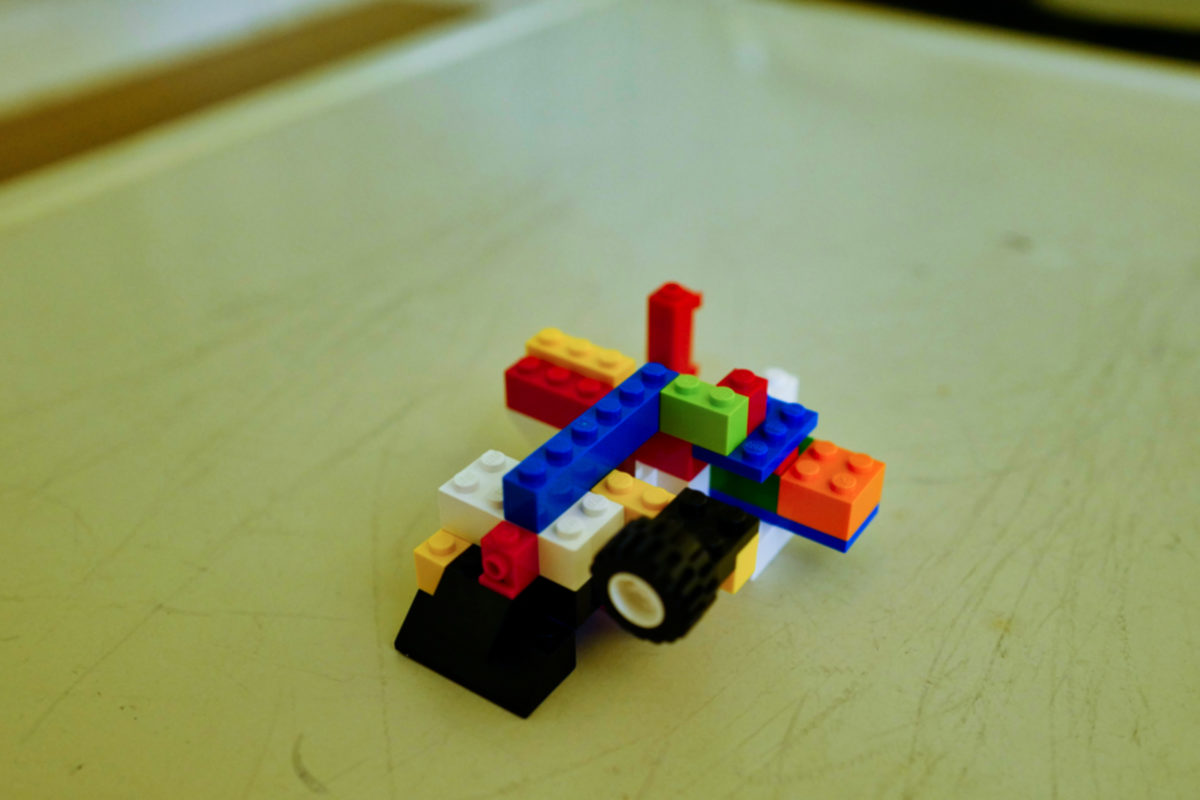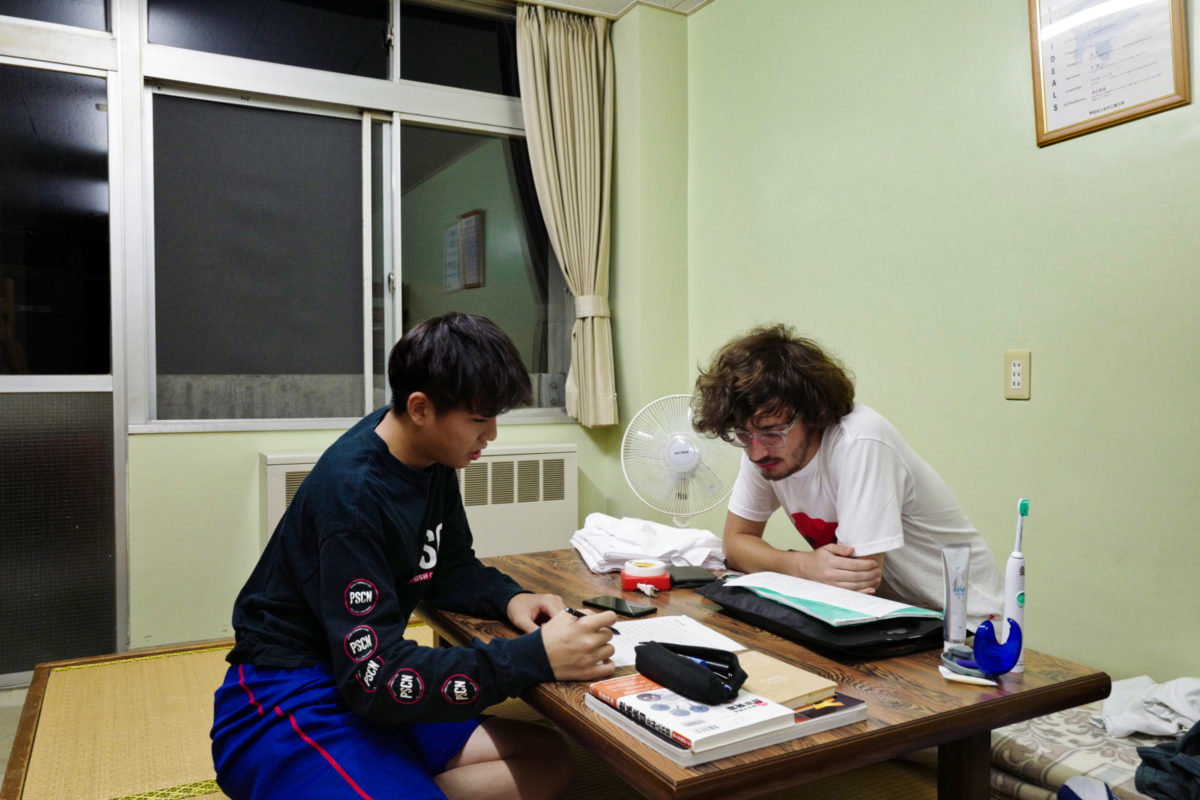Students have been on vacation for about one month and a half from the beginning of August to the end of September. During that time, they went back to their homes and could relax. They also had to work on a STEM project of their choice and then present it at a fair at Hakusanroku campus. “STEM” stands for science, technology, engineering and mathematics, so students had a wide variety of choices for their projects depending on their interests.
The STEM fair was held on September 26th. Students each presented their project in English with a poster and some even brought props from their project. These projects ranged from building a remote controlled car to measuring the effectiveness of house cleaning products on killing mold to surveying Japanese people and foreigners on their ratio preference for pictures. The students put a lot of work and effort into their projects and it was nice to see the fruits of their labor. Doing projects of that scope in a second language is not easy, but they did a great job.
All teachers who came to see the projects were invited to evaluate them. The two best students were awarded with a first and second prize. Furthermore, an additional four students were awarded with a special award. These six winners will have to present their projects again during the ICT school festival that will take place on October 20th and 21st. Good luck to the students and I hope many people will come to encourage them!
Jason de Tilly
10月5日 STEMフェア
白山麓キャンパスの学生は8月のはじめから9月の終わりまで、夏休みで学校を離れていました。その間は自宅へ戻り、リラックスすることができたと思います。ただ、同時に、白山麓キャンパスで開催されるSTEMプロジェクトの発表準備をする必要がありました。STEMはscience(科学)、technology(技術)、engineering(工学)、mathematics(数学)の略で、学生は自分の興味に合わせて、広い範囲の中から研究テーマを選ぶことができます。
9月26日、STEMプロジェクトを発表するSTEMフェアが開催されました。各学生はポスターや製作したものを展示して、英語で発表を行いました。プロジェクトは、ラジコンカーを製作するもの、家庭用洗剤のカビへの効き目を測るもの、日本人と外国人に街頭インタビューを実施して黄金比の好みを比較するものまで様々でした。学生がプロジェクトに費やした努力の成果を見ることができて良かったです。このスケールのプロジェクトを第二言語で行うことは決して簡単ではありませんが、学生たちはよく頑張ったと思います。
発表を見るために訪れた先生には評価シートが配られました。もっとも優秀だった2人の学生には大賞が、追加で4人に特別賞が贈られました。この6人の学生は10月20日~21日に開催される国際高専の「高専祭」でもう一度プロジェクトの発表を行います。学生らにエールを送りつつ、たくさんの応援がもらえるように祈っています。
ジェイソン・デ・ツィリー
Hi again. This is Maesa and I’m one of the facilitators at the Hakusan-roku campus. I hope everyone had a good summer break and are ready to come back to learn something new and exciting. This semester I continue to teach Computer Skills and Engineering Design classes. One great thing about having the same course for multiple semesters is that we can explore more advance topics since these courses build upon one another. During the last semester the students were able to build something amazing with an introductory knowledge. I cannot wait to see what they build next after a little bit of experience and more advance topics.
Thanks,
—Maesa
お久しぶりです。白山麓キャンパスの先生のひとり、メイサです。皆さん良い夏休みを過ごせましたか?エキサイティングで、新しいことをたくさん学ぶ準備は出来ていますか?私は前学期に引き続きもコンピュータースキルズとエンジニアリングデザインを担当します。同じ科目を2学期連続して学ぶことによって、より深く掘り下げて、高度な内容に取り組むことが出来ます。前学期、学生たちは学んだ基礎知識で素晴らしいものを作ることに成功しました。更なる経験と、より高度なテーマに取り組むことによって、どのようなものを作るのか非常に楽しみです。
メイサ
Hello, it's Jonathan the camera guy. This week, the first-years students participated in the Anamizu Seminar at the Anamizu Bay Seminar House. The Anamizu seminar is an annual three-day event where students strengthen their English skill and relationship with each other through marine activities and spending time together.
The Anamizu Bay Seminar House is in Hosu District, in the middle of Noto peninsula. It is about three hours by bus from Hakusanroku campus and consists of the main building with dormitories and seminar rooms, and a harbor for marine activities.
DAY 1
After arriving at Anamizu, the seminar began with a welcome speech from the director, Mitsuhiko Sugawara. He explained that he hoped the students would learn sympathy, discipline and leadership through their experience. Then, students were divided into their dormitory rooms. Each room had one or two English speaking teachers, and the students used this opportunity to refresh their English after the summer break.
The first day was mostly orientation and preparation for the following days. Students practiced the procedures of the morning and evening assembly. It was a militaristic and crisp experience. However, the students seemed relaxed and enjoying the disciplined atmosphere.
After dinner, we continued our tradition of the learning session (evening school). Students practiced singing the school song and prepared for their book report presentation. On the morning of the final day, students would give a three to four minute presentation on the books they read over the summer break in English. Many students came to me and other teachers to check their grammar.
DAY 2
Day two was the big day for the marine activities. We woke up at 6:30 to gather outside for rollcall and exercised.
After breakfast, we walked down to the harbor and prepared for the marine activities. First, we took a tour of Anamizu bay on a large cruiser. The weather was perfect and many students took the opportunity to relax and chat with their friends. Others who were interested joined Mr. Sugawara in the main cabin to ask about the ship's radar, sonar and other equipment. The tour lasted for about an hour.
Next, the students learned to tie knots in a ropework class. According to the teacher, a good knot is a knot that is simple to tie, does not come loose easily, but is easy to untie when needed. We learned various knots for tying ropes together or to a pole. The activity ended with everyone tying their ropes together in a circle and leaning outward to see if the knot would hold everyone's weight. Afterward, we returned to the seminar house for lunch.
After lunch, we began the preparation for the main event, the cutter boat race. The cutter boat we used was a rowboat for nine passengers, which include six oarsmen, one standby, the first mate and the captain. Students and teachers were divided into two teams and began practicing. Maneuvering the heavy cutter was not easy, especially because it was our first time. The oars were 7.2 kilograms each and the cutter was almost a ton with all nine passengers. It was about 26 degrees outside and even with the cool sea breeze, sweat glistened on the necks of the oarsmen as they pulled the oars through the water. Rowing is more about synchronization than individual strength, and everyone called out "so-re" in unison as they rowed.
The captain is the only passenger facing forward and is responsible for giving all the orders, calling out the timing of the strokes and steering the cutter. This was a complicated task with many decisions and things to memorize.
At first, each team struggled to control the cutter. The captain forgot her orders and which direction to turn the control lever, and the oarsmen bumped their oars together. However, after a couple of rounds around the harbor, both teams were ready for their race.
The two teams competed how fast they could circle two buoys placed in the ocean. The first obstacle was to maneuver the ship around the first buoy. The wind was blowing from the right and the captain had to calculate how far to turn the ship in order to move straight and turn the corner. After the first buoy was the long home stretch. Now the wind was blowing toward us and it was up to the oarsmen's strength and coordination to progress forward. All passengers joined their hearts and voices together as the finishing buoy grew closer until they finally crossed the finishing line.
After returning to solid ground, we held an award ceremony. The winning team was group one who finished in 7 minutes and 29 second. Both teams seemed happy with their hard work and rejoiced together. The prize was a huge box full of snacks which the students shared with each other.
The second evening session was a special activity designed by the learning mentors to improve the students' English skills using LEGO blocks. In the first half, students were divided into groups of three. Their task was to build a shape using four LEGO blocks and create a manual to come with it. The manual had to be written in English and in a way that the other groups could build an identical shape without looking at the finished product.
In the second half, the students were divided into groups of four, each with a pile of LEGO blocks. Ryan sensei had secretly built a construction behind a curtain. The students' goal was to recreate Ryan sensei's construction with the pieces they had. However, there was a catch. The teams were divided into two recorders and two builders. The recorders could go and look at the construction behind the curtains but could not touch the pieces. The builders could touch the pieces but could not look at the Ryan sensei's model. In addition, both sides could only use English. These activities were fun and challenged the students to think of creative ways to communicating in English.
After the learning session, many students worked on finishing their book reports. The presentations were the following morning and they worked late into the night. The seminar was definitely an exercise for both the body and mind.
DAY 3
The third and final day also began at 6:30 with the morning assembly. After breakfast, the book reports took place in the seminar room. Each student introduced their books by giving brief overviews or explaining things that interested them. The book reports reflected the effort students had put into them and I was happy that they took it quite seriously.
Finally, we held the closing ceremony. Director Sugawara expressed his hopes that the students would follow the values they learned during this seminar and become great engineers in the future. In turn, students promised to show how much they grew to the Anamizu staff in next year's seminar. Everyone packed their bags and boarded the bus to return to Hakusanroku campus.
Altogether, I believe the Anamizu Seminar was crisp, refreshing and an excellent way to start the new semester after a long summer break. The group activities helped cultivate individual strength as well as bonds between the students. There were many incidents of students helping each other such as warning them of the time, encouraging them during the cutter practice and simply being considerate. Also, I observed growth in the students who took up leading roles in the assemblies, ceremonies and marine activities. All students overcame various challenges, both physical and mental, that strengthened them as individuals and as a group. I will continue to observe the growth of these young engineers.
2018年9月21日 穴水研修からスタートする新学期!
穴水湾自然学苑は能登半島の中央、鳳珠郡にあります。白山麓キャンパスからはバスで約3時間の距離にある宿泊型研修施設で、海洋活動のためのハーバーがあります。
研修は苑長の菅原光彦先生の挨拶で始まりました。挨拶の中で、苑長先生は学生に規律、礼儀、共同の精神をこの研修で学んで欲しいと話してくれました。その後、学生はそれぞれ共同で寝泊まりする部屋に分けられました。各部屋には1人~2人の外国の先生が一緒に滞在します。学生はこの機会を利用して夏休みで鈍ってしまった英語のリフレッシュをしました。
1日目
1日目の主な活動はオリエンテーションと準備活動でした。朝夕の集いでは規律を学びました。ビシッとした厳粛な雰囲気でしたが、学生はリラックスしている様子で、規律ある雰囲気を楽しんでいるようでした。
夕食のあと、白山麓キャンパスと同じようにラーニングセッション(夜の学校)がありました。学生は校歌の練習や、英語で行うブックレポートに取り組みました。研修の最終日には発表会があり、各学生3~4分間で夏休みに読んだ本を紹介します。中には文法チェックをお願いする学生もいました。
2日目
2日目はいよいよ海洋活動の日でした。6時半に起床し、朝の集いのために外に集合して、ラジオ体操で体を温めました。
まずは、大きな船で穴水湾の見学ツアーを行いました。天候も良く、学生は友達とおしゃべりをしたり、リラックスしたりしていました。興味がある学生は船長室で菅原苑長からレーダーやソナーなどの船の機材について話を聞いていました。ツアーは1時間ほどで終わりました。
次はロープ・ワークで様々な紐の結び方について学びました。指導の先生によれば、良い結び方とは、結び方が単純で、簡単に解けないが、解こうと思えばすぐに解けるものだそうです。ロープ・ワークでは、ロープ同士や、木の棒に結んだりする様々な結び目を練習しました。最後には何人かでそれぞれのロープを結び合わせ、輪になって外に体重をかけてもロープが解けないかを試しました。ロープ・ワークのあとは戻って昼食を食べました。
昼食のあとは、カッター漕艇に挑みました。今回使用したカッターは漕ぎ手9名、補助1名、副艇長1名、艇長1名の合計9人乗りです。学生と先生が2班に分かれ、レースに向けて練習を始めました。カッターは乗組員合わせて重量1トン近くになります。全員カッター初心者だったので、最初は上手く操作ができませんでした。気温は26度で、涼しい潮風の中でも、1本7.2キログラムのオールを漕ぐ者の首筋に汗が光っていました。カッター漕艇は個人の力よりシンクロが重要になる競技なので、タイミングを合わせるために全員「ソーレ!」と掛け声を上げていました。
艇長は唯一前を向いている乗員で、全ての指示、漕ぎ手のタイミング、カッターの操縦を任されます。記憶することや、同時に考えなければならないことが多く、複雑で責任の重い役割です。
はじめは、各チームカッターの操作に苦戦していました。艇長は指示を忘れ、操縦桿の倒す方向を間違え、漕ぎ手もオールを互いにぶつけました。数回ハーバーを回るうちに少しずつ慣れていき、いよいよレースの時間となりました。
レースでは、両チームが海に浮かんだ2つのブイを通過するタイムを競います。最初の課題はまっすぐ進んでひとつ目のブイを曲がることです。艇長は右から吹く風を計算して船を操縦しなければなりません。ひとつ目のブイを曲がると、今度は長い直線です。風が正面から吹いており、漕ぎ手の力に頼らなければ前に進めません。乗員全員が声と心をひとつにし、少しずつ近づいてくるゴールを目指して、力を合わせて無事ゴールしました。
レースのあとは表彰式が行われました。優勝は7分29秒でゴールした第1班でした。両チームは満足げで、互いを称えていました。優勝賞品はお菓子が入った大きな箱で、学生はこれを分け合っていました。
2回目のラーニングセッションでは、レゴブロックを使って英語を強化するアクティビティに取り組みました。前半では、レゴブロックを4つ組み合わせたものを作り、それを設計するマニュアルを英語で作成しました。マニュアルは、他の学生が完成品を見ずとも正確に同じものが作れるように作成しなければいけませんでした。
後半では4人のグループに分かれて、更に英語のコミュニケーション能力を試す活動を行いました。ライアン先生がカーテンの裏である形を組み立てたあと、それと同じパーツが入ったレゴブロック一式が学生に配られました。学生の目標はライアン先生と同じ形のものを作ることです。しかし、ただ作るだけではありません。4人中2人はカーテンの裏のものを見ることができますが、ブロックを組み立てることができません。残り2人は組み立てることはできますが、見ることができません。さらに、全員英語しか使うことができません。複雑なレゴブロックの組み方を正確に伝えるクリエイティブな方法を考える必要があり、学生たちは頭をひねっていました。
ラーニングセッションのあと、多くの学生はブックレポートの仕上げに取り掛かりました。発表会は翌朝に迫っており、夜中遅くまで作業を続ける人もいました。心身共に鍛えられる1日になりました。
3日目
最終日も6時半に起きて朝の集いを行いました。朝食のあと、研修室でブックレポートの発表会がありました。学生は選んだ本の概要や、興味があった内容などを紹介しました。それぞれの発表に準備の跡が見られ、真剣に取り組んだことが感じられました。
最後に退苑式が執り行われました。菅原苑長は研修で学んだ規律、礼儀、共同の心得を忘れずに励んでほしいと激励の言葉を述べました。学生は来年の研修で成長した姿を見せることを約束しました。その後、バスに乗って白山麓キャンパスへ帰りました。
今回の穴水研修は新鮮な気持ちで新学期をスタートする良いものになったと思います。グループ活動を通してお互いの絆を強くできました。10分前行動の声かけをする人や、海洋活動で仲間を気遣う人など、助け合いの精神がありました。さらに、朝夕の集いや、海洋活動でリーダーを務めた学生は大きな成長が見られました。参加した学生は様々な活動を通して、身も心も鍛えられ、仲間との絆が深まったと思います。今後の成長も楽しみです。
One downside for having only twelve students on campus is the lack of sport clubs. Many Hakusanroku campus students play sports after school. I often encounter students playing basketball, badminton, table tennis, and volleyball after the evening learning session and there is definitely an upside of living on campus. However, it is difficult to find large competition because the older students currently all study at the Kanazawa campus.
Yesterday, I visited a first-year student who is utilizing his summer vacation to overcome this situation. Yuya Kida is improving his skill by joining the Kanazawa campus badminton club during the summer. Unlike at the Hakusanroku campus where he can beat almost everyone easily (me included), his seniors are much stronger than him. It was interesting to see Yuya be the timid "youngling" when he usually plays so confident.
Even I could tell that his seniors were at a different level. Their speed, strength and precision overpowered Yuya. The sound of their smash was distinctively louder and different from his. I talked to Yuya and he said that defeating them is his current goal, however that it was far from coming true. The two seniors that practiced with him this day were kind and showed Yuya how they practiced and encouraged him to join in. The three practiced for two hours before packing up. I hope similar interaction between the two campuses increases in the future.
Jonathan
2018年9月4日
白山麓キャンパスでは、放課後にスポーツを楽しむ学生をよく見かけます。しかし、12名という学生数の関係で、まだスポーツ系の部活動がほとんどありません。夜のラーニングセッションの後に体育館で、バスケットボール、バドミントン、卓球、バレーボールができるのは全寮制の利点ですが、競争相手が足りているとは言い難いです。
先日、夏休みを利用してこの状況を打開した学生に会いました。1年生の喜田湧也さんは金沢キャンパスのバドミントン部の練習に加わって先輩から指導を受けています。白山麓キャンパスではほとんど敵なしの彼ですが、先輩にはまったく敵わないといいます。普段は自信満々にプレイする彼が、先輩を前にして緊張している姿を見るのはとても新鮮でした。
素人の私が見ても、先輩との力の差は歴然でした。スピード、パワー、精密性が数段階上で、スマッシュの音がまったく違いました。喜田さんに話を聞くと「当面の目標は先輩を倒すことだが、しばらくは叶いそうにない」と話してくれました。私が訪れた日に一緒に練習していた2人の先輩は、緊張していた喜田さんに練習の仕方や、手本など見せていました。3人の練習は2時間ほど続きました。今後も、白山麓キャンパスと金沢キャンパスのこのような交流が増えることを期待しています。
ジョナサン
Hello! I am Ryan Vicencio, one of the Learning Mentors at the Hakusanroku campus. I facilitate the evening learning sessions, helping the students with their homework and various projects. Right now, the students are off campus, enjoying their summer vacation. The summer programs have ended, and many teachers are starting to go on vacation as well. Campus is very quiet.
In contrast, the michi no eki across the street is bustling with life.
This station, called Sena, is a popular rest stop for tourists looking to experience the beautiful scenery that the Hakusan area has to offer.
Sena sports an omiyage shop and several cafes, and is the site for local events ranging from musical performances to classic car meet-ups. During the summer, the cafes sell ice cream to beat the heat, and with this summer being one of the hottest, ice cream is a must.
There are three options for ice cream at Sena, but the students’ and teachers’ unanimous favorite is the ice cream at a cafe called the Kijitora Coffee Research Lab (キジトラコーヒー研究所). Students would often be found there after afternoon classes and club activities, enjoying some unique soba tea ice cream or freshly made karaage. Sometimes, even teachers would end their work day with a delicious coffee float or some silky chocolate ice cream.
If you get the chance to visit campus, you should stop by for a chance at seeing the one of the cats after which the shop is named!
Ryan Vicencio
こんにちは!白山麓キャンパスのラーニングメンターのひとり、ライアン・ビセンシオです。夜のラーニングセッションで、学生の宿題や様々なプロジェクトを手伝っています。現在、学生はキャンパスを離れ、夏休みを満喫しています。夏のプログラムも全て終了し、旅行に行く先生が増えてキャンパス内はとても静かです。
対照的に、道路の反対側にある道の駅は大賑わいを見せています。
瀬女(せな)と呼ばれるこの道の駅は、白山エリアの美しい自然を体感しようと訪れる観光客の人気の休憩スポットとなっています。
瀬女にはお土産店とカフェが数店舗あり、音楽会からクラシックカーのオフ会まで、様々なイベントが開催されています。夏の間はカフェのソフトクリームで暑さをしのぐことができます。今年の夏は特に暑いのでソフトクリームの摂取は必須です。
瀬女のソフトクリームは3つの選択肢がありますが、国際高専の学生、先生満場一致のおすすめはキジトラコーヒー研究所です。放課後に訪れるとよくそば茶ソフトクリームや、揚げたてのから揚げを食べている学生の姿を見かけることができます。美味しいコーヒーフロートや、なめらかなチョコレートソフトクリームで一日の仕事を締めくくる先生も少なくありません。
白山麓キャンパスを訪れる際には、ぜひカフェの名前の由来にもなっている猫に会いに行くことをおすすめします。
ライアン・ビセンシオ
(訳:ジョナサン)













































